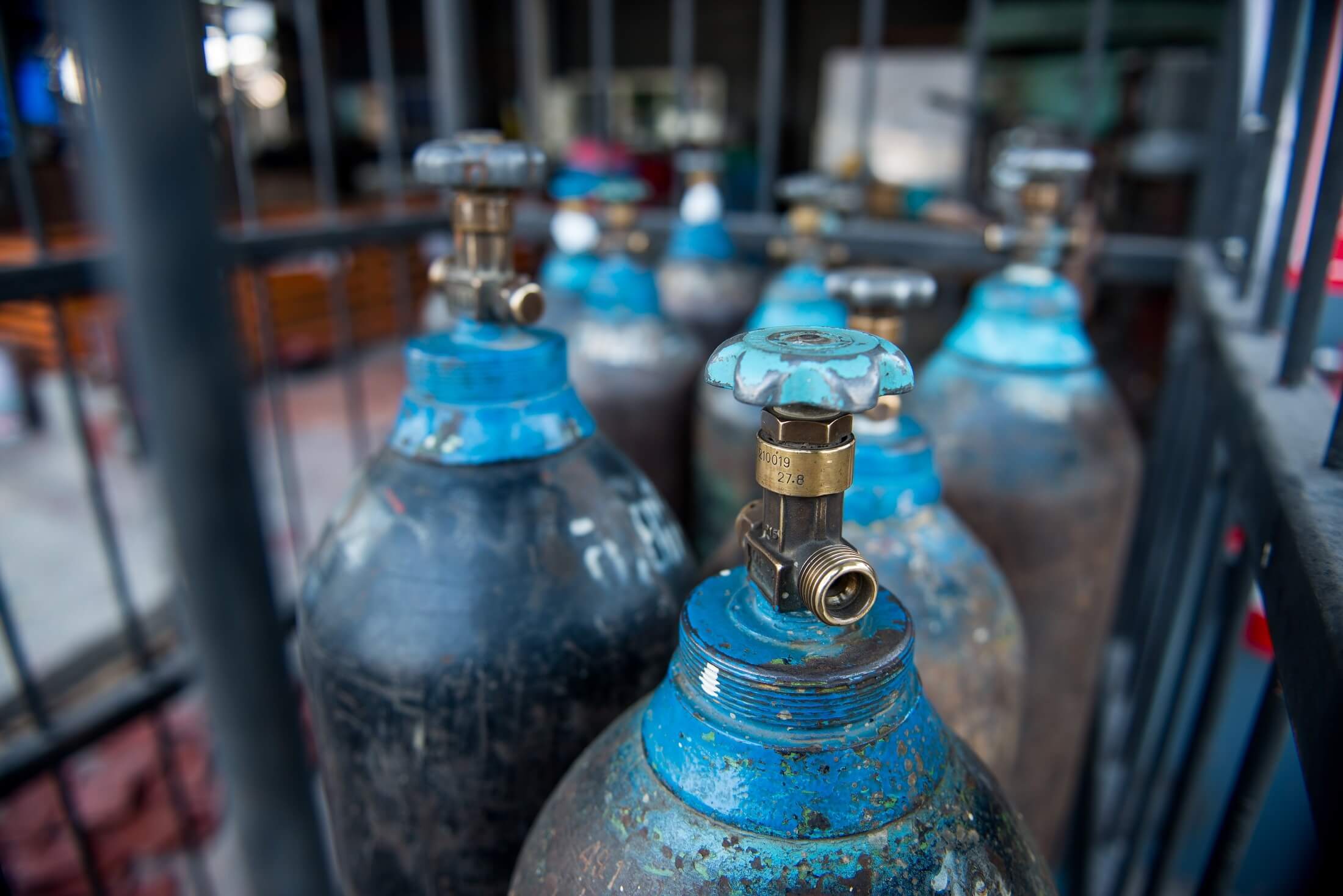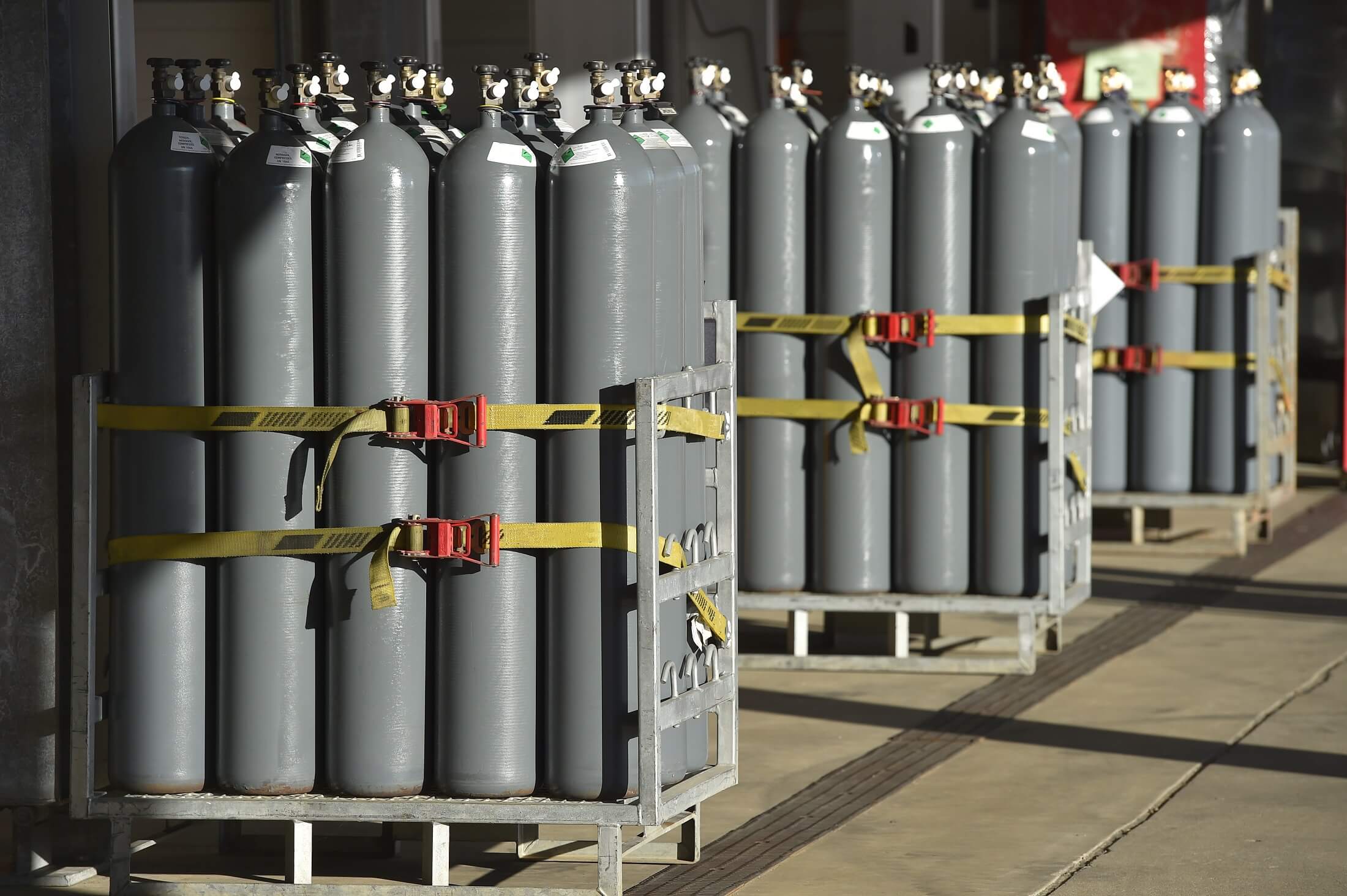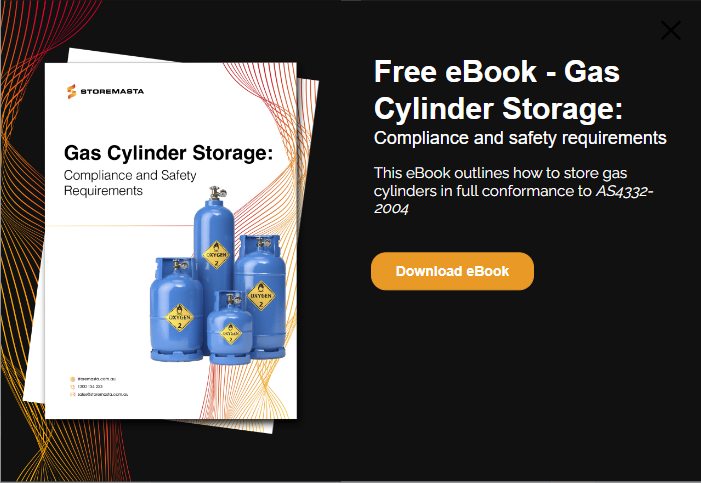Why are Class 2.2 Non-Flammable, Non-Toxic Gases dangerous and how can you store them in a safe and compliant manner? It’s a question that we often get asked by customers who are assessing their Dangerous Goods storage requirements. Inert gases can be often thought of as being ‘harmless’, when in fact they should be treated with extreme care. While they may be classed as non-flammable and non-toxic, this type of gas is still subject to specific handling and storage requirements — just like all other classes of Dangerous Goods. This blog focuses on Class 2.2 storage essentials and identifies the key documents required to ensure chemical compliance in your workplace.
Defining Non-Flammable, Non-Toxic Gases
In Australia, the management of Dangerous Goods (including Class 2.2 Non-Flammable, Non-Toxic Gases) is influenced by several different Regulations and Standards.

While they aren’t toxic nor flammable, Class 2.2 gases are still classed as Dangerous Goods and are subject to WHS Regulations and Australian Standards.
Class 2.2 Non-Flammable, Non-Toxic Gases are classified by the Australian Dangerous Goods (ADG) Code — which follows the guidelines of the Globally Harmonised System of Classification and Labeling of Chemicals (GHS) (adopted and released by the United Nations).
Within the Class 2: Gases category of Dangerous Goods, there are 3 types of gases.
These include:
- Division 2.1: Flammable Gases
- Division 2.2: Non-Flammable, Non-Toxic Gases
- Division 2.3: Toxic Gases
For Division 2.2 Non-Flammable, Non-Toxic Gases, the official definition is supplied by the ADG Code, which states:
Gases which are asphyxiants (gases which dilute or replace the oxygen in the atmosphere); or are oxidizing (gases which may, generally by providing oxygen, cause or contribute to the combustion of other material more than air does).
What Are Some Examples Of Non-Flammable, Non-Toxic Gases?
Class 2.2 Non-Flammable, Non-Toxic Gases are widely used in a variety of industries — as well as households.
Some examples of these gases include:
- helium
- compressed air
- carbon dioxide
- nitrogen
- argon
What Are The Risks And Hazards Of Non-Flammable, Non-Toxic Gases?
It’s important to note that some types of non-flammable, non-toxic gases have been responsible for serious workplace incidents — as well as fatalities. Cylinders containing Class 2.2 Non-Flammable, Non-Toxic Gases that are mishandled or stored incorrectly can result in asphyxiation, explosions and violent chemical reactions.

Just like any class of Dangerous Goods, you must handle and store your Class 2.2 gases in a safe and compliant manner.
Any class of Dangerous Goods must be handled and stored in a safe, compliant manner if you are to reduce risk in your workplace.
You should always be aware of the risks associated with the handling and storage of Class 2.2 Non-Flammable, Non-Toxic Gases. We recommend conducting a chemical risk assessment for all areas of your business where these gases are present. This will allow you to accurately identify any potential hazards and implement effective control measures to reduce the risk.
Some considerations may include the following risks associated with Class 2.2 gases:
1. Gas Leaks
The air we breathe contains approximately 21.1% oxygen. Environments with an oxygen content below 19.5% are considered unsafe.
Any gases (including Class 2.2 Non-Flammable, Non-Toxic Gases) that leak into a confined space can displace the oxygen in the air. This oxygen-deficient environment will create an asphyxiation hazard that can harm workers, supervisors, contractors and any other visitors to your site.
SOLUTION: Cylinder stores should be well-ventilated and, if possible, located outside. Regular inspections should be conducted on gas cylinders and their valves, to check for issues such as leaks, worn threading and other structural damage.
2. Damage To Gas Cylinders
Dropped or impacted cylinders can rapidly disperse gas. The gas cylinders can also rupture or explode.
When gas cylinders rapidly disperse gases, they can generate enough speed and velocity to become airborne. These cylinders can quickly travel through the air like a torpedo, causing serious harm and damage. It’s important to remember that many workers have been killed or seriously injured from out-of-control gas cylinders.
SOLUTION: You should always use mechanical lifting devices to move or handle cylinders. When cylinders are in storage, they must be restrained with safety straps or chains to reduce the risk of human harm and property damage.
3. Exposure To Dangerous Events
Gas cylinders containing non-flammable, non-toxic gases are also capable of rupturing and exploding when exposed to dangerous events.
Heat from fires, industrial machinery, and even direct sunlight can cause cylinders to rupture violently from pressure build-up. Cylinder explosions often result in deaths, environmental and property damage.
SOLUTION: It’s crucial that gas cylinders are correctly stored. This means that they should be located away from sources of heat, incompatible substances, hazardous chemicals and combustibles.
4. Contact With Incompatible Substances
If a Class 2.2 Non-Flammable, Non-Toxic Gas is also classified as an oxidising gas, it can react with other classes of Dangerous Goods.
Oxidising gases, such as oxygen, can be particularly dangerous when they come into contact with heat, flames or flammable substances.
When Class 2.2 gases are also classified as oxidising gases, you must separate them from incompatible Dangerous Goods.
Failure to do so can result in the gas:
- Starting fires quickly and making them burn hotter, with more intensity
- Making slow burning combustibles ignite and burn faster
- Reacting with combustible materials and create fires without ignition sources
You should also note that there are specific segregation requirements that apply to gas cylinder stores which contain multiple types of Class 2 gases.
The Standard states the segregation requirements when storing more than one type of Class 2 gas in a store:
4.4.3 Segregation within the store
Segregation of gas cylinders within the store shall comply with the following:
(a) Gases of Class 2.1 shall be segregated from those of Class 2.3 or Class 2.2/5.1 by at least 3 m.
(b) Gases of Class 2.3 shall be segregated from gases of Class 2.1 or 2.2/5.1 by at least 3 m. NOTE: Gases of Class 2.2 may be used to segregate the above gases.

You must always refer to the Dangerous Goods segregation chart to ensure that your Class 2.2 gases are not coming into contact with incompatible chemicals.
SOLUTION: To avoid a chemical reaction with incompatible substances, you should carry out thorough risk assessments of gas compatibility. The first step should be to thoroughly review the Safety Data Sheet (SDS) of gases, plus the SDS of other hazardous chemicals that are used and stored in your workplace.
How Do You Safely Store Class 2.2 Gases?
Class 2.2 Non-Flammable, Non-Toxic Gases are Dangerous Goods and must be stored safely in a way that is compliant with AS 4332 - The storage and handling of gases in cylinders.
There are three key elements to storing non-flammable, non-toxic gases safely. These are:
1. Gas Cylinder Store Location
Compressed gases in cylinders should be stored outdoors wherever possible. Because Class 2.2 gases present asphyxiation risks, outdoor storage is ideal because the natural ventilation often disperses leaked gases safely.
The Standard also requires that cylinder stores are level, or suitably sloped if drainage is required. Any slight slop must not compromise the stability of the gas cylinders.
AS 4332:2004 also explains that gas cylinder stores must be located at least 3 metres away from any source of industrial heat —as well as combustible materials, vegetation and refuse.
2. The Provision Of Ventilation
Section 4.3 of the Standard explains that the ventilation system of gas cylinder stores shall be capable of diluting and removing any gas or vapour to acceptable levels within workplace exposure limits. To reduce risk, these levels must also be below any possible explosion levels.
If adequate natural ventilation is not possible, a mechanical ventilation system must be installed on any indoor gas cylinder stores. A mechanical ventilation system may include exhaust fans, ducting, alarms and monitoring controls.
3. Gas Cylinder Restraints
To reduce the risk of gas cylinders becoming airborne missiles in the workplace, cylinder restraints are required. All gases in cylinders must be stored in an upright position, preferably in a secure gas bottle cage.
Each cylinder must be individually restrained using safety straps or chains. Cylinder valves must always be closed, with the attachments removed and safety caps/plugs in place.
How Is Your Workplace Storing Class 2.2 Gases?
While being classed as non-flammable and non-toxic, you should not be mistaken for thinking that these gases are harmless. As we’ve explained in this blog, Class 2.2 gases pose a range of serious risks — from asphyxiation to explosions. If your business is carrying any type of Class 2.2 Non-Flammable, Non-Toxic Gases, you must refer to the requirements of the Australian Standard to ensure you’re handling and storing these gas cylinders safely.
Would you like to find out more about managing the risks and hazards associated with compressed gases stored in cylinders? Then why not access our free eBook, Gas Cylinder Storage: compliance and safety requirements? Our easy-to-read guide unpacks the requirements of AS 4332:2004 - The storage and handling of gases in cylinders and provides practical advice for getting your workplace 100% safety compliant. Download our free guide today by simply clicking on the image below.
Joining the team as a Dangerous Goods Storage Consultant, Melissa Hampton became Storemasta's Marketing Manager in late 2021. With extensive knowledge and experience in chemical compliance, Melissa is responsible for leading the Marketing team and helping shape their marketing strategy. In her spare time, you can find Melissa hiking, swimming and enjoying the great outdoors in beautiful north-west Tasmania.
